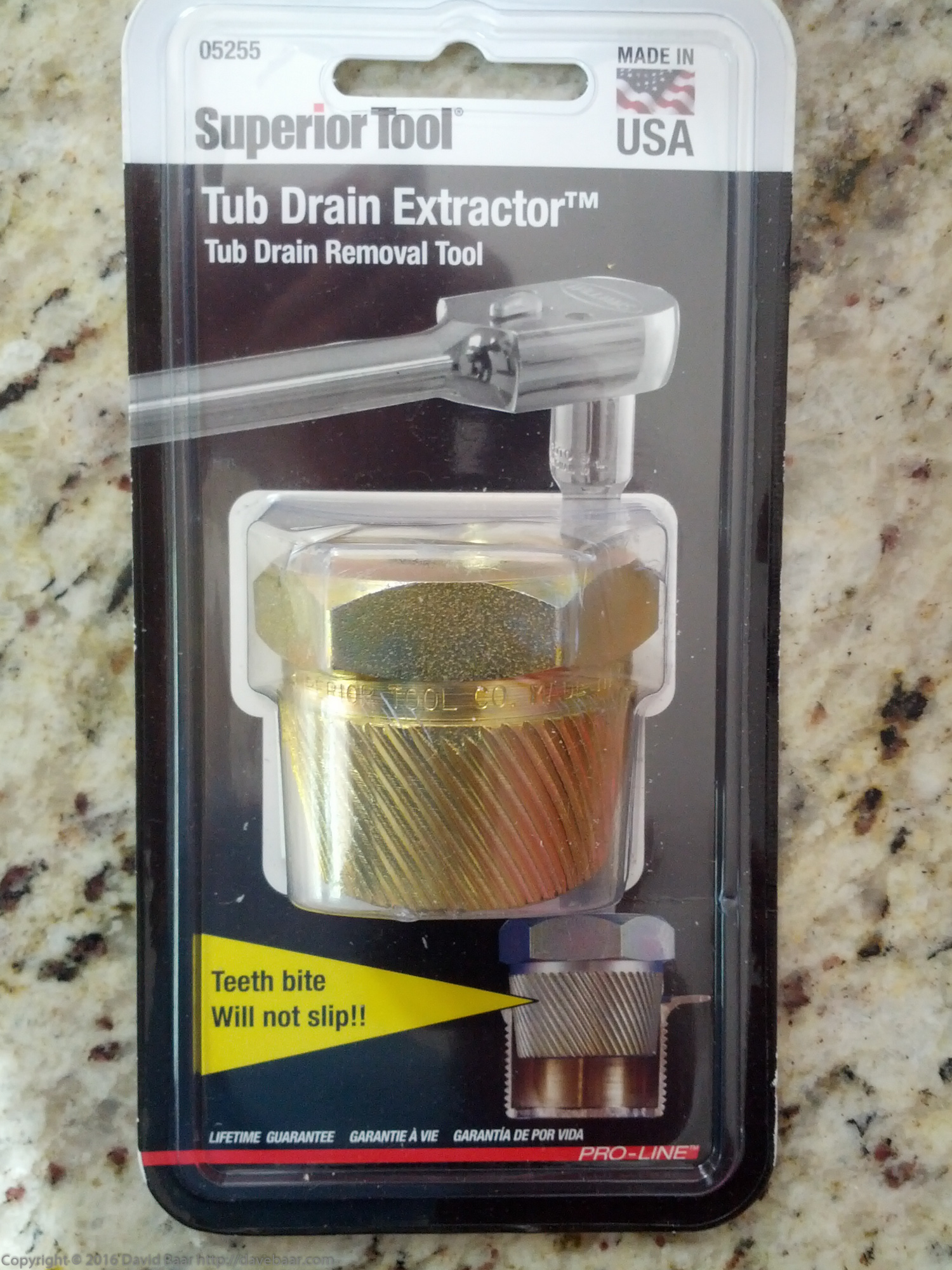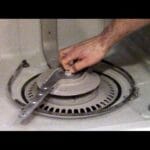Is your bathroom tub drain causing you headaches with its broken crosshairs? It’s a common issue that can turn a relaxing bath into a frustrating ordeal.
You might be wondering how you can tackle this problem without calling in expensive professionals. The good news is that you can fix it yourself with a little guidance. You’ll discover straightforward steps to remove a tub drain with broken crosshairs, saving you time, money, and stress.
Imagine the satisfaction of solving this problem on your own and restoring your bathroom to its tranquil state. Keep reading to find out how you can take control and make your tub drain hassle-free again.

Credit: www.davebaar.com
Tools And Materials Needed
Removing a tub drain with broken crosshairs requires specific tools and materials. Essential items include a drain removal tool, pliers, and a screwdriver. Ensure you have a bucket and towels ready for cleanup.
Removing a tub drain with broken crosshairs can feel like a daunting task. But with the right tools and materials, you can tackle this challenge with confidence. Don’t let the thought of plumbing repairs intimidate you—equipping yourself properly is half the battle won.Gather Your Tools
Start by collecting the essential tools. You’ll need a drain removal tool, commonly known as a tub drain wrench. This tool is specifically designed to grip and turn the drain, even when the crosshairs are broken. A sturdy pair of pliers is a must-have. Needle-nose pliers are particularly useful for gripping tight spots. Having a screwdriver set handy is a smart move, especially if the drain is secured with screws. Make sure you have both Phillips and flathead types.Essential Materials
Put on a pair of durable work gloves to protect your hands. Plumbing tasks can be hard on the skin, so this simple step can save you discomfort later. Have a flashlight ready. Good lighting helps you see clearly into the drain and makes the job easier. Don’t forget a bucket to catch any water left in the pipes. This avoids a mess and keeps your workspace clean.Additional Supplies
Consider having a penetrating oil on hand. This can help loosen stubborn parts that have become corroded over time. A towel or rag is great for wiping surfaces clean. It’s surprising how much grime can accumulate, and this simple tool will keep your area tidy. Lastly, keep a notebook and pencil nearby. Jotting down notes or sketches of your progress can be a lifesaver if you need to remember the steps later. Why not take a moment to think about how prepared you feel? Having the right tools not only makes the task easier but also boosts your confidence. Are there any other tools you think might be helpful? Let your imagination guide you, and you might find new ways to make your project smoother.
Credit: www.superiortool.com
Assessing The Damage
Removing a tub drain with broken crosshairs can be challenging. First, assess the damage. This helps determine the best approach. It’s crucial to understand what you’re dealing with. Begin by inspecting the tub drain’s current state. Look for visible cracks or severe wear. This will guide your repair process.
Start by checking the drain’s surface and surrounding area. If the crosshairs are broken, they may cause further issues. Broken pieces can block water flow. This creates a bigger problem over time. Carefully observe the drain to ensure no additional obstructions exist.
Identify Visible Cracks
Take a close look at the drain surface. Cracks can worsen the situation. Small cracks might seem harmless at first. Yet, they can expand quickly. Water pressure may increase damage over time. Identifying these cracks early is crucial. It helps prevent future problems.
Check For Blockages
Blockages can occur due to broken crosshairs. These pieces can obstruct water flow. Ensure the drain is clear. Use a flashlight to see inside the drain. Blockages can cause slow draining. They may lead to water damage. Clearing them is an essential step.
Evaluate Surrounding Area
The surrounding area of the drain is important. Check for water stains or damage. This indicates leaks or drainage issues. Assess the tiles and tub surface. Damaged surfaces may require additional repairs. A thorough evaluation helps plan the next steps.
Consider The Drain’s Age
Older drains may need extra attention. Age can weaken materials. This increases the chance of damage. Consider replacing old components. New parts might be more durable. They can prevent future issues. Replacement could be a wise investment.
Safety Precautions
Protect your hands by wearing gloves while removing a tub drain with broken crosshairs. Use safety goggles to shield your eyes from debris. Ensure proper ventilation in the area to avoid inhaling fumes from cleaning agents or rust removers.
Removing a tub drain with broken crosshairs can be a challenging task, but ensuring your safety should always come first. Before you dive into the nitty-gritty of the removal process, it’s crucial to prepare yourself with the right safety precautions. Proper safety measures not only protect you but also ensure the job is done efficiently and effectively.Wear Protective Gear
Always start by wearing the right protective gear. Gloves are essential to shield your hands from sharp edges or debris. Safety goggles protect your eyes from unexpected flying particles. Consider wearing a mask to avoid inhaling dust or particles, especially if you’re working in a confined bathroom space.Ensure Proper Ventilation
Good ventilation is often overlooked, but it’s vital. Bathrooms can be small and poorly ventilated, making them a breeding ground for harmful fumes if you’re using chemicals. Open a window or use a fan to keep the air fresh and safe to breathe.Check Your Tools
Inspect your tools before you begin. A damaged wrench or screwdriver can slip and cause injury. Make sure all your tools are in good condition and suitable for the task. Using the wrong tool can complicate the process and increase the risk of accidents.Turn Off Water Supply
You might think, “Why turn off the water if I’m working on a drain?” But unexpected leaks can occur, turning a simple task into a messy ordeal. Shut off the water supply to prevent any unforeseen water damage.Be Mindful Of Your Surroundings
In the excitement of getting the job done, it’s easy to overlook your surroundings. Keep your workspace organized. Ensure the floor is dry to avoid slipping, and clear away any obstacles that might cause you to trip.Plan For Emergencies
Even with the best precautions, accidents can happen. Keep a first-aid kit nearby. Know the quickest route to the nearest hospital in case of severe injuries. Preparation could make all the difference in an emergency. How confident are you in your safety measures? Taking these precautions seriously not only protects you but also builds your confidence to tackle the task at hand. Safety isn’t just a checklist—it’s a mindset that ensures you can return to your work, day after day.Accessing The Drain
Dealing with a broken tub drain can be frustrating. Accessing the drain is the first step in fixing the issue. Knowing the right techniques can make this process easier and more efficient.
Tools Required For Accessing The Drain
Gather essential tools before starting. A screwdriver, a wrench, and pliers are necessary. These tools help remove the drain cover and access the broken crosshairs. Having them ready ensures a smooth workflow.
Prepare The Workspace
Clear the area around the tub. Remove any items that might obstruct your work. Ensure the tub is dry to prevent slipping. This creates a safe environment and helps focus on the task.
Removing The Drain Cover
Locate the screws holding the drain cover. Use a screwdriver to carefully unscrew them. Lift the cover gently to avoid further damage. This step gives access to the drain’s interior.
Inspecting The Drain
Once the cover is removed, inspect the drain. Look for any visible damage. Assess the extent of the broken crosshairs. This helps plan the next steps effectively.
Understanding The Drain Structure
Familiarize yourself with the drain’s structure. Knowing how it is assembled aids in understanding the repair process. Identify key components that might need attention.
Accessing The Broken Crosshairs
Using pliers, reach inside the drain. Carefully access the broken crosshairs. Grip them firmly and prepare to remove them. This step is crucial for repair.
Accessing the drain is a significant part of repair. With the right tools and preparation, the task becomes manageable. Follow each step methodically for effective results.
Removing The Broken Crosshairs
Removing a tub drain with broken crosshairs involves using basic tools. Carefully unscrew and lift the drain. Ensure no debris is left.
Removing a tub drain with broken crosshairs might seem daunting, but it’s entirely doable with the right approach and tools. Whether you’re a seasoned DIY enthusiast or someone tackling this for the first time, understanding the process is key to success. Let’s dive into the details and make this task as straightforward as possible.Understanding The Problem
The crosshairs in a tub drain are those small metal pieces that you often see when you look down the drain. They serve to hold the stopper in place. When these crosshairs break, it can make removing the drain more challenging. But don’t worry, addressing this issue is manageable with some patience and the right tools.Gather The Necessary Tools
Before you start, ensure you have the right tools on hand. You’ll need a pair of needle-nose pliers, a screwdriver, and possibly a tub drain wrench. It’s also handy to have a flashlight to see what you’re dealing with more clearly. Having the right tools will make the process smoother and prevent unnecessary frustration.Step-by-step Removal Process
1. Assess the Damage: Use a flashlight to inspect the extent of the breakage. Understanding how much of the crosshairs remain will guide your approach. 2. Remove the Stopper: If the stopper is still in place, gently use the screwdriver to remove it. This will give you better access to the broken crosshairs. 3. Use Needle-Nose Pliers: Carefully insert the pliers into the drain and grip the remains of the crosshairs. Twist gently to see if you can unscrew the drain. 4. Try a Tub Drain Wrench: If the pliers don’t work, a tub drain wrench might be necessary. This tool is designed to fit into the drain and provide better leverage. Insert the wrench and turn counter-clockwise.Dealing With Stubborn Drains
Sometimes, the drain just doesn’t want to budge. If this happens, don’t panic. Consider applying a lubricant like WD-40 to loosen any rust or buildup. Let it sit for a few minutes before trying again. Patience is crucial here, and sometimes stepping away for a short break can provide a fresh perspective.Why Persistence Pays Off
You might wonder if all this effort is worth it. Absolutely! Successfully removing a broken drain can save you money and give you the satisfaction of a job well done. Plus, it empowers you to handle future plumbing challenges with confidence. Have you ever faced a home repair that seemed overwhelming at first? How did you overcome it? Share your experiences and let’s learn from each other.Cleaning The Drain Area
Removing a tub drain with broken crosshairs requires careful attention. Use pliers to grip the crosshairs and twist gently. If stuck, apply lubricant to loosen the drain.
Cleaning the drain area is an essential first step when removing a tub drain with broken crosshairs. A clean workspace ensures you have a clear view and prevents any accidental slips. It also makes the process smoother, allowing you to focus on the task at hand without distraction.Clear The Surrounding Area
Start by removing any bath mats, bottles, or toiletries around the tub. This will give you ample space to maneuver. It also prevents any items from accidentally falling into the tub, which can be frustrating when you’re in the middle of a project.Gather Your Cleaning Supplies
You’ll need a few basic supplies such as a sponge, a mild cleaning solution, and a towel. A mixture of warm water and dish soap works wonders. It’s gentle yet effective in removing soap scum and grime.Wipe Down The Tub
Use a damp sponge with your cleaning solution to wipe down the tub. Focus on the area around the drain, ensuring it’s free of any buildup. A clean surface will help you see the broken crosshairs more clearly.Dry The Area Thoroughly
After cleaning, use a towel to dry the area completely. Wet surfaces can be slippery and dangerous. A dry tub also helps in getting a better grip when you start working on the drain.Inspect The Drain
Once the area is clean and dry, take a closer look at the drain. Can you see any debris that could be causing additional issues? Make a mental note or use a flashlight to spot any hidden obstacles. Cleaning might seem like a chore, but it’s a vital step in preparing to remove a tub drain with broken crosshairs. Have you ever tackled a project, only to realize midway that a clean workspace would have made things easier? Taking the time to clean not only sets the stage for a successful repair but also saves time in the long run.Installing A New Drain
Installing a new drain can seem daunting at first. Yet, with the right tools and steps, it becomes manageable. A new drain ensures your tub functions well and looks clean. It also prevents leaks and blockages. Follow this guide to install your new tub drain effortlessly.
Gather The Necessary Tools
First, collect the tools required for the installation. You’ll need a wrench, a screwdriver, and plumber’s putty. Having these tools ready makes the process smooth and efficient.
Clean The Drain Area
Ensure the drain area is spotless. Remove debris or old sealant. A clean surface allows the new drain to fit securely. Use a cloth to wipe away dust and dirt.
Apply Plumber’s Putty
Take a small amount of plumber’s putty. Roll it into a thin rope with your hands. Place the putty around the bottom edge of the new drain flange. This step helps prevent future leaks.
Install The New Drain
Gently place the new drain into the tub’s opening. Ensure it sits evenly. Use a wrench to tighten the drain securely. Avoid overtightening to prevent damage.
Test For Leaks
Once installed, run water to check for leaks. Look for any water escaping around the drain. If no leaks appear, the installation is successful. Adjust if necessary to ensure a tight seal.
Clean Up
Finally, clean the area around the drain. Remove any excess putty with a cloth. Ensure the tub surface is smooth and dry. This final step gives your tub a polished finish.
Testing The New Drain
Removing a tub drain with broken crosshairs requires careful handling. Use pliers or a drain extractor tool to grip and twist the damaged crosshairs. Ensure a firm grip to avoid further damage while dislodging the drain.
Testing a new drain can be both exciting and nerve-wracking. After the effort of removing a tub drain with broken crosshairs, the last thing you want is to find out the new installation isn’t working properly. But don’t worry—testing the new drain is straightforward and can save you from future headaches.Inspect The Drain Installation
Before running any water, take a close look at the installed drain. Is it securely fitted? Make sure there are no visible gaps or misalignments. These could lead to leaks or inefficient drainage. Inspect the surrounding area as well. Any leftover debris or sealant might obstruct the flow. A clean installation area often ensures a smoother test run.Run A Basic Water Test
Turn on the faucet and let the water flow into the tub. Watch as the water spirals down the drain. Does it flow smoothly, or are there any signs of pooling? Listen for unusual sounds. A well-installed drain should be quiet. Gurgling or slow drainage might indicate underlying issues.Check For Leaks
While the water is running, inspect the underside of the tub. Leaks can often be spotted here first. Use a flashlight to check for any water droplets or dampness. A simple paper towel can help. Wipe it along the joints and connections. If it comes back wet, further tightening or resealing might be needed.Assess Water Flow Rate
Observe how quickly the water drains. Does it match your expectations? A slow drain might be a sign of blockage or improper installation. Consider comparing it to a previous setup. Was the older drain faster or slower? This can help gauge if adjustments are necessary.Ask Yourself: Is Everything Functioning Correctly?
Does the new drain meet your expectations? If not, what could be improved? Sometimes small tweaks can make all the difference. Reflect on the process. Was there anything in the installation that could have been done differently? Your insights could be valuable for future projects. Testing a new drain might seem mundane, but it’s an essential step. By ensuring everything is in perfect working order, you can enjoy your tub without worry. Have you had any challenging experiences with plumbing? Share your story and see what tips others have to offer!Maintenance Tips
Maintaining your bathroom fixtures is essential for long-lasting performance. A tub drain with broken crosshairs can be a headache. Regular maintenance prevents costly repairs. Let’s dive into some effective maintenance tips.
Check For Clogs Regularly
Clogs can worsen the condition of a broken drain. Clear debris weekly to keep water flowing smoothly. Use a simple drain cleaner or a plunger for minor blockages.
Inspect The Drain For Damage
Look for any visible cracks or damage around the drain. Early detection can save you from bigger issues. Use a flashlight to inspect hard-to-see areas.
Use The Right Tools
Always use tools designed for plumbing tasks. Incorrect tools can cause more damage. Invest in a good quality wrench and pliers.
Apply Lubricant To Moving Parts
Lubricate the drain parts to reduce friction. This helps them move smoothly. A silicone-based lubricant works best for this purpose.
Schedule Professional Maintenance
Regular professional inspections ensure everything is in top shape. An expert can spot issues you might miss. This can extend the life of your drain.
Educate Your Household
Everyone should know how to care for bathroom fixtures. Teach them basic maintenance tasks. This prevents unintentional damage and keeps drains functioning well.

Credit: www.youtube.com
Troubleshooting Common Issues
Dealing with a tub drain with broken crosshairs can be frustrating. Identifying common issues is crucial to fixing the problem effectively. This section aims to guide you through troubleshooting these issues.
Identifying The Drain’s Current Condition
Start by examining the drain closely. Look for visible damage or wear. Broken crosshairs often indicate corrosion or physical damage. Understanding the current state helps in choosing the right tools.
Assessing Tools And Equipment Needs
Gather the necessary tools before starting. You might need pliers, a drain removal tool, or a wrench. Proper tools ensure a smooth repair process. Check if you need specialized equipment for stubborn drains.
Understanding Common Blockages
Blockages often complicate drain removal. Hair, soap scum, or debris can obstruct the drain. Use a flashlight to inspect inside the drain for blockages. Clear these before attempting further repairs.
Evaluating Wear And Tear
Wear and tear can affect drain removal. Older drains may have rust or mineral deposits. These factors can make removal challenging. Consider applying penetrating oil to ease the process.
Recognizing Signs Of Severe Damage
Severe damage might require professional help. Cracks or severe rust suggest a deeper issue. If the drain is heavily damaged, DIY methods might not suffice. Recognize these signs early to avoid further complications.
Frequently Asked Questions
How Do You Identify Broken Tub Drain Crosshairs?
Check for missing or damaged metal in the drain. Water may also drain slowly.
What Tools Are Needed To Remove A Broken Tub Drain?
You will need a drain extractor, screwdriver, pliers, and possibly a wrench.
Can I Remove A Broken Tub Drain Myself?
Yes, with the right tools and care, you can do it yourself.
How Long Does It Take To Remove A Broken Tub Drain?
It typically takes about 30 minutes if you have the tools ready.
What Should I Do If The Drain Won’t Come Out?
Apply more force carefully. You may need a professional if it remains stuck.
Conclusion
Removing a tub drain with broken crosshairs isn’t too hard. With the right tools, it’s manageable. Start by gathering pliers and a drain key. Next, follow the steps carefully. Take your time to avoid further damage. Remember, patience is crucial.
If uncertain, don’t hesitate to ask a friend. Safety first, always wear gloves. Completing this task saves money on plumbers. A little effort goes a long way. Your bathroom will be back in shape soon. Enjoy the satisfaction of fixing it yourself.
Keep learning and tackling small home repairs. It builds confidence and skills.




